Strategic Management Report: Approaches for Toyota Motors Analysis
VerifiedAdded on 2020/03/28
|16
|3460
|179
Report
AI Summary
This report provides a comprehensive analysis of Toyota Motors' strategic management approaches. It begins with an executive summary outlining the report's focus on stakeholder analysis, dynamic capabilities, and sustainable practices within the organization. The introduction sets the stage by defining strategic management and its two main approaches, industrial organization and sociological. The report then delves into three key approaches: the stakeholder approach, examining system theory and Toyota's stakeholder groups and CSR initiatives; dynamic capabilities, discussing organizational theory and Toyota's use of the resource-based view; and the sustainable approach, focusing on the triple bottom line and Toyota's CSR efforts. The report includes tables and figures to illustrate stakeholder analysis and concludes by summarizing the key findings and their implications for Toyota's strategic management. The analysis covers various aspects of Toyota's operations, including its employees, customers, investors, communities, and the environment, highlighting how the company addresses these stakeholders' interests through various CSR initiatives, resource allocation, and sustainable practices.
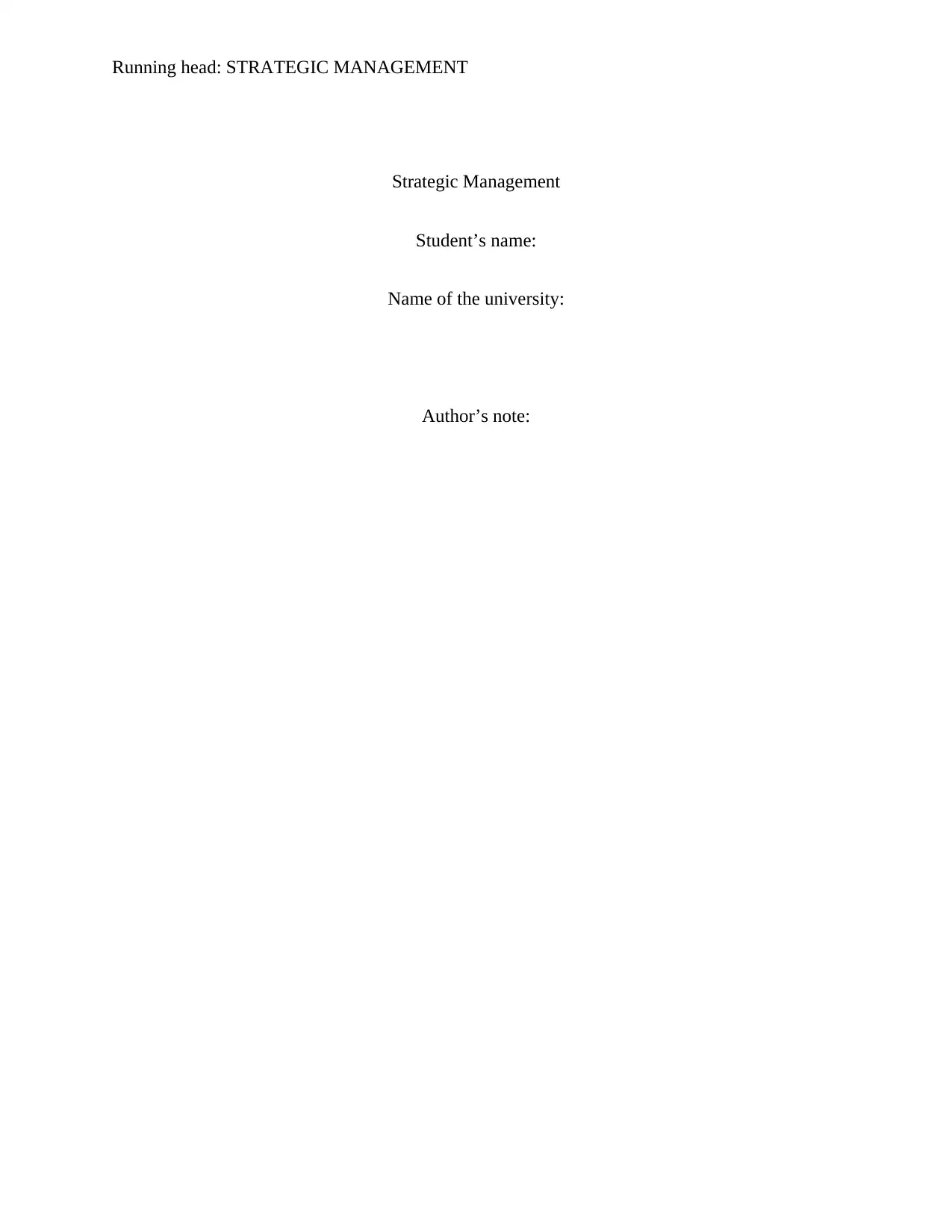
Running head: STRATEGIC MANAGEMENT
Strategic Management
Student’s name:
Name of the university:
Author’s note:
Strategic Management
Student’s name:
Name of the university:
Author’s note:
Paraphrase This Document
Need a fresh take? Get an instant paraphrase of this document with our AI Paraphraser
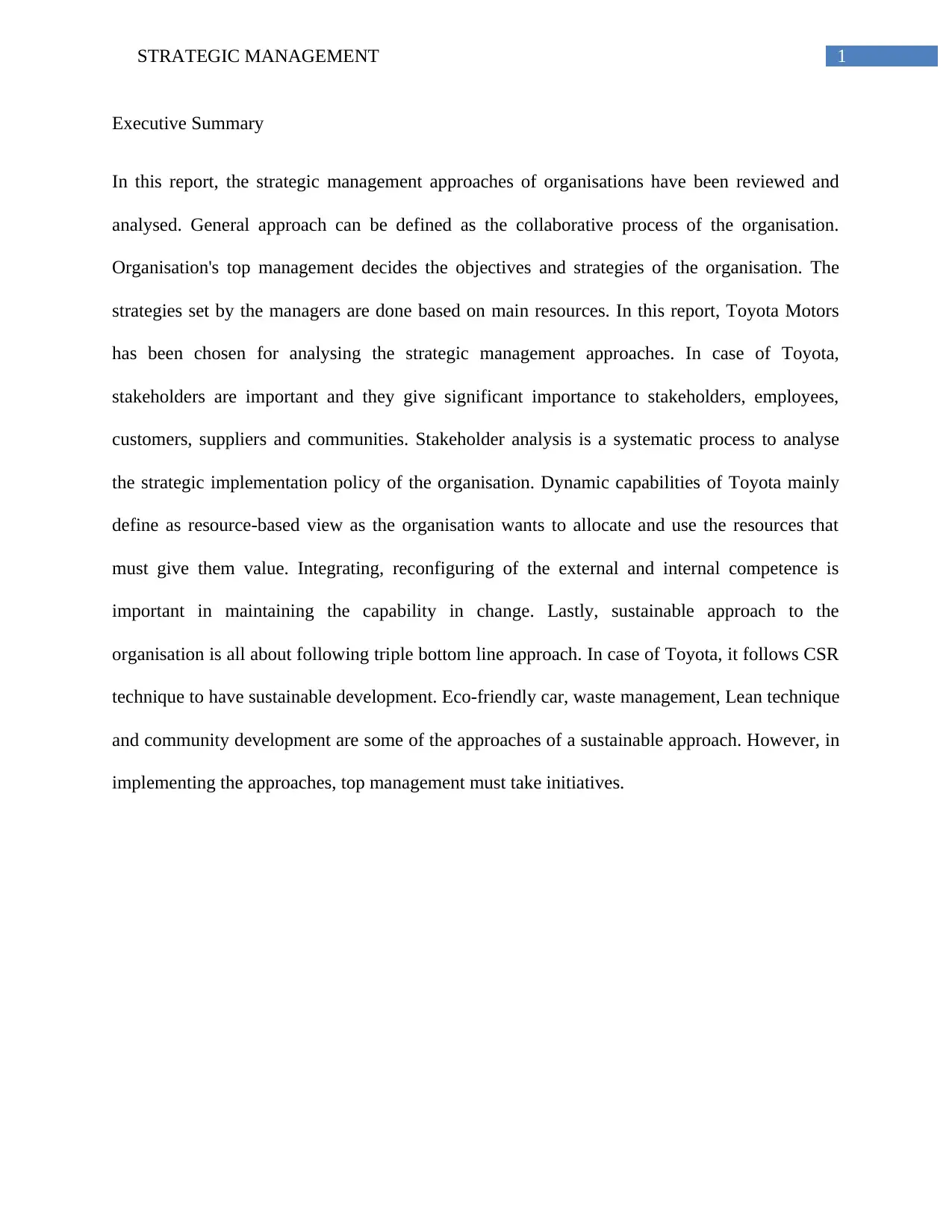
1STRATEGIC MANAGEMENT
Executive Summary
In this report, the strategic management approaches of organisations have been reviewed and
analysed. General approach can be defined as the collaborative process of the organisation.
Organisation's top management decides the objectives and strategies of the organisation. The
strategies set by the managers are done based on main resources. In this report, Toyota Motors
has been chosen for analysing the strategic management approaches. In case of Toyota,
stakeholders are important and they give significant importance to stakeholders, employees,
customers, suppliers and communities. Stakeholder analysis is a systematic process to analyse
the strategic implementation policy of the organisation. Dynamic capabilities of Toyota mainly
define as resource-based view as the organisation wants to allocate and use the resources that
must give them value. Integrating, reconfiguring of the external and internal competence is
important in maintaining the capability in change. Lastly, sustainable approach to the
organisation is all about following triple bottom line approach. In case of Toyota, it follows CSR
technique to have sustainable development. Eco-friendly car, waste management, Lean technique
and community development are some of the approaches of a sustainable approach. However, in
implementing the approaches, top management must take initiatives.
Executive Summary
In this report, the strategic management approaches of organisations have been reviewed and
analysed. General approach can be defined as the collaborative process of the organisation.
Organisation's top management decides the objectives and strategies of the organisation. The
strategies set by the managers are done based on main resources. In this report, Toyota Motors
has been chosen for analysing the strategic management approaches. In case of Toyota,
stakeholders are important and they give significant importance to stakeholders, employees,
customers, suppliers and communities. Stakeholder analysis is a systematic process to analyse
the strategic implementation policy of the organisation. Dynamic capabilities of Toyota mainly
define as resource-based view as the organisation wants to allocate and use the resources that
must give them value. Integrating, reconfiguring of the external and internal competence is
important in maintaining the capability in change. Lastly, sustainable approach to the
organisation is all about following triple bottom line approach. In case of Toyota, it follows CSR
technique to have sustainable development. Eco-friendly car, waste management, Lean technique
and community development are some of the approaches of a sustainable approach. However, in
implementing the approaches, top management must take initiatives.
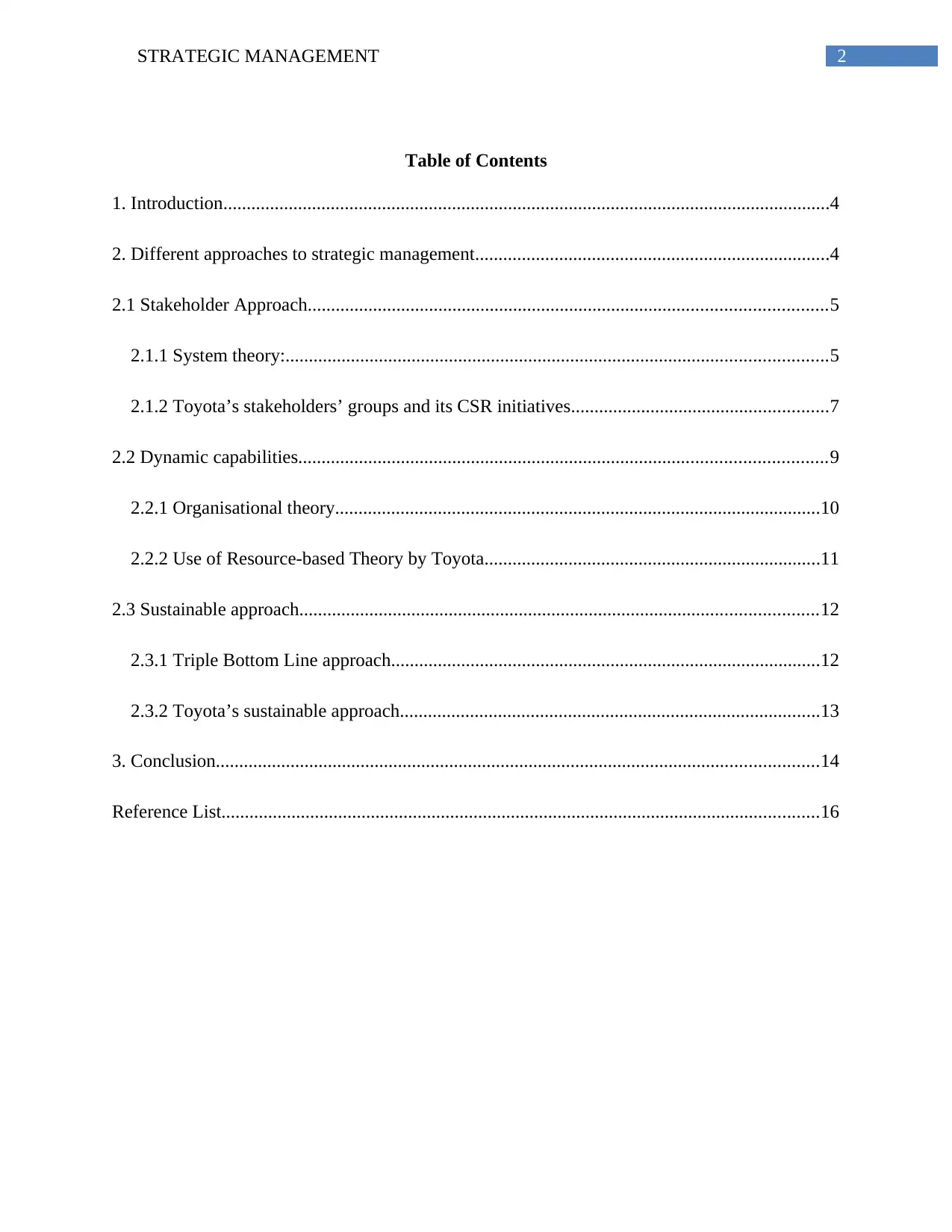
2STRATEGIC MANAGEMENT
Table of Contents
1. Introduction..................................................................................................................................4
2. Different approaches to strategic management............................................................................4
2.1 Stakeholder Approach...............................................................................................................5
2.1.1 System theory:....................................................................................................................5
2.1.2 Toyota’s stakeholders’ groups and its CSR initiatives.......................................................7
2.2 Dynamic capabilities.................................................................................................................9
2.2.1 Organisational theory........................................................................................................10
2.2.2 Use of Resource-based Theory by Toyota........................................................................11
2.3 Sustainable approach...............................................................................................................12
2.3.1 Triple Bottom Line approach............................................................................................12
2.3.2 Toyota’s sustainable approach..........................................................................................13
3. Conclusion.................................................................................................................................14
Reference List................................................................................................................................16
Table of Contents
1. Introduction..................................................................................................................................4
2. Different approaches to strategic management............................................................................4
2.1 Stakeholder Approach...............................................................................................................5
2.1.1 System theory:....................................................................................................................5
2.1.2 Toyota’s stakeholders’ groups and its CSR initiatives.......................................................7
2.2 Dynamic capabilities.................................................................................................................9
2.2.1 Organisational theory........................................................................................................10
2.2.2 Use of Resource-based Theory by Toyota........................................................................11
2.3 Sustainable approach...............................................................................................................12
2.3.1 Triple Bottom Line approach............................................................................................12
2.3.2 Toyota’s sustainable approach..........................................................................................13
3. Conclusion.................................................................................................................................14
Reference List................................................................................................................................16
⊘ This is a preview!⊘
Do you want full access?
Subscribe today to unlock all pages.

Trusted by 1+ million students worldwide
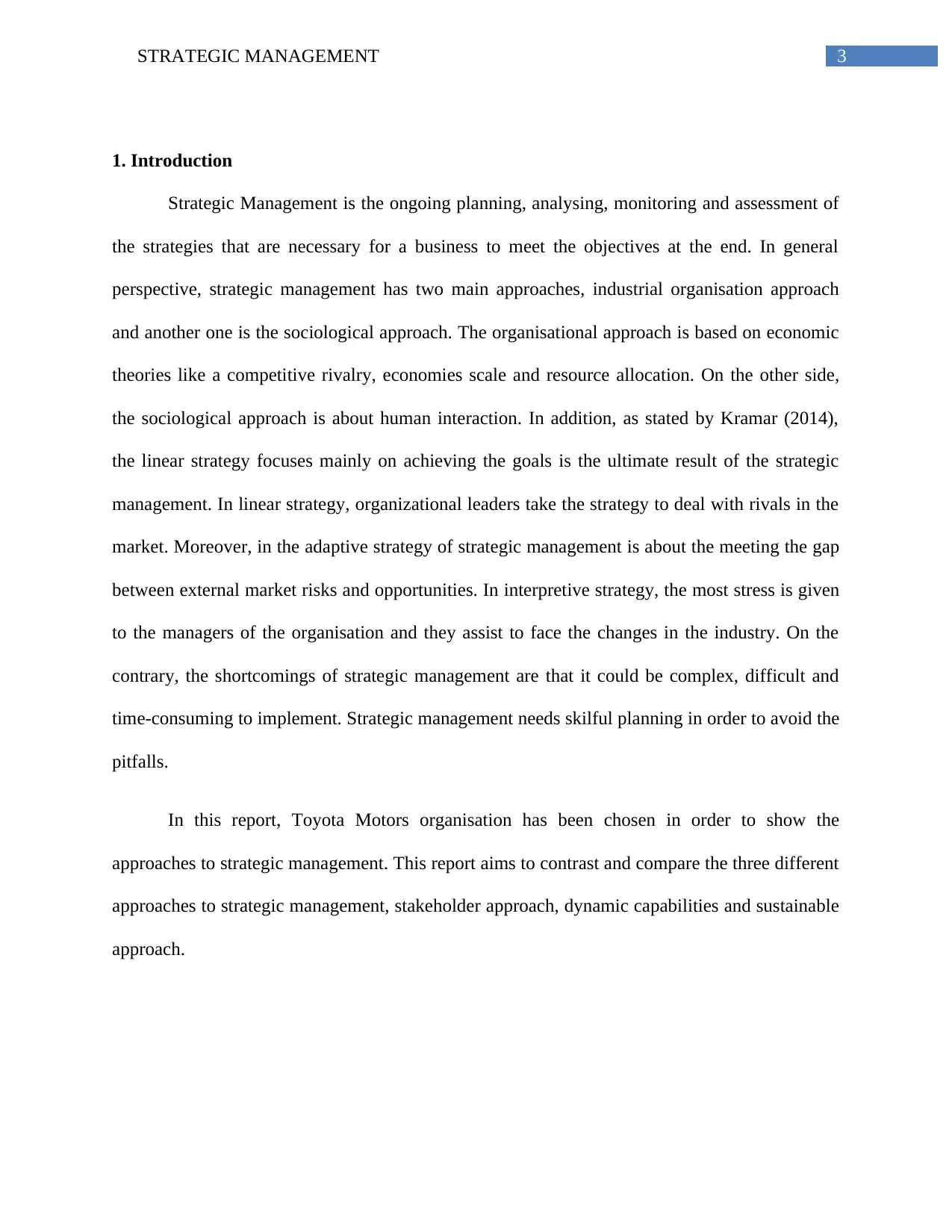
3STRATEGIC MANAGEMENT
1. Introduction
Strategic Management is the ongoing planning, analysing, monitoring and assessment of
the strategies that are necessary for a business to meet the objectives at the end. In general
perspective, strategic management has two main approaches, industrial organisation approach
and another one is the sociological approach. The organisational approach is based on economic
theories like a competitive rivalry, economies scale and resource allocation. On the other side,
the sociological approach is about human interaction. In addition, as stated by Kramar (2014),
the linear strategy focuses mainly on achieving the goals is the ultimate result of the strategic
management. In linear strategy, organizational leaders take the strategy to deal with rivals in the
market. Moreover, in the adaptive strategy of strategic management is about the meeting the gap
between external market risks and opportunities. In interpretive strategy, the most stress is given
to the managers of the organisation and they assist to face the changes in the industry. On the
contrary, the shortcomings of strategic management are that it could be complex, difficult and
time-consuming to implement. Strategic management needs skilful planning in order to avoid the
pitfalls.
In this report, Toyota Motors organisation has been chosen in order to show the
approaches to strategic management. This report aims to contrast and compare the three different
approaches to strategic management, stakeholder approach, dynamic capabilities and sustainable
approach.
1. Introduction
Strategic Management is the ongoing planning, analysing, monitoring and assessment of
the strategies that are necessary for a business to meet the objectives at the end. In general
perspective, strategic management has two main approaches, industrial organisation approach
and another one is the sociological approach. The organisational approach is based on economic
theories like a competitive rivalry, economies scale and resource allocation. On the other side,
the sociological approach is about human interaction. In addition, as stated by Kramar (2014),
the linear strategy focuses mainly on achieving the goals is the ultimate result of the strategic
management. In linear strategy, organizational leaders take the strategy to deal with rivals in the
market. Moreover, in the adaptive strategy of strategic management is about the meeting the gap
between external market risks and opportunities. In interpretive strategy, the most stress is given
to the managers of the organisation and they assist to face the changes in the industry. On the
contrary, the shortcomings of strategic management are that it could be complex, difficult and
time-consuming to implement. Strategic management needs skilful planning in order to avoid the
pitfalls.
In this report, Toyota Motors organisation has been chosen in order to show the
approaches to strategic management. This report aims to contrast and compare the three different
approaches to strategic management, stakeholder approach, dynamic capabilities and sustainable
approach.
Paraphrase This Document
Need a fresh take? Get an instant paraphrase of this document with our AI Paraphraser
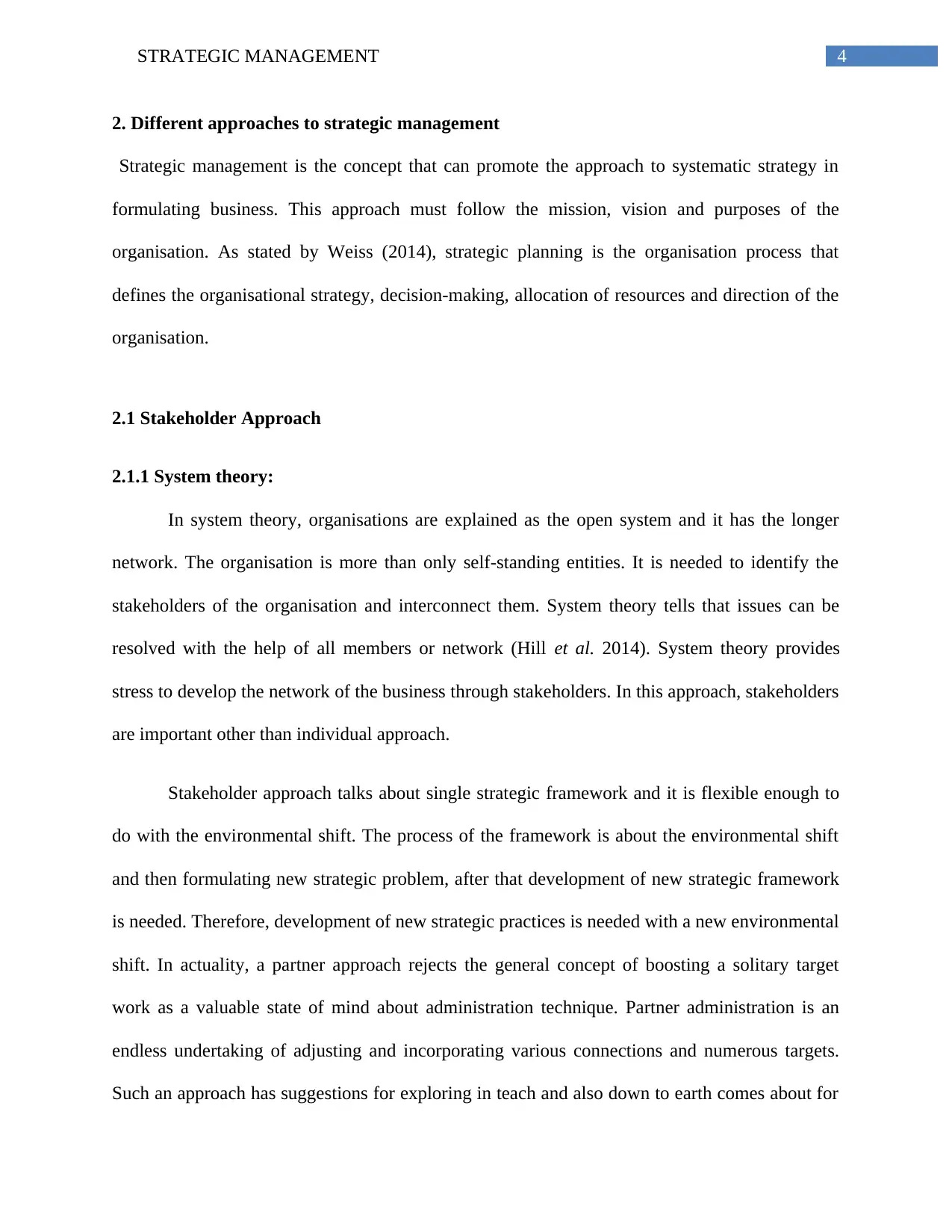
4STRATEGIC MANAGEMENT
2. Different approaches to strategic management
Strategic management is the concept that can promote the approach to systematic strategy in
formulating business. This approach must follow the mission, vision and purposes of the
organisation. As stated by Weiss (2014), strategic planning is the organisation process that
defines the organisational strategy, decision-making, allocation of resources and direction of the
organisation.
2.1 Stakeholder Approach
2.1.1 System theory:
In system theory, organisations are explained as the open system and it has the longer
network. The organisation is more than only self-standing entities. It is needed to identify the
stakeholders of the organisation and interconnect them. System theory tells that issues can be
resolved with the help of all members or network (Hill et al. 2014). System theory provides
stress to develop the network of the business through stakeholders. In this approach, stakeholders
are important other than individual approach.
Stakeholder approach talks about single strategic framework and it is flexible enough to
do with the environmental shift. The process of the framework is about the environmental shift
and then formulating new strategic problem, after that development of new strategic framework
is needed. Therefore, development of new strategic practices is needed with a new environmental
shift. In actuality, a partner approach rejects the general concept of boosting a solitary target
work as a valuable state of mind about administration technique. Partner administration is an
endless undertaking of adjusting and incorporating various connections and numerous targets.
Such an approach has suggestions for exploring in teach and also down to earth comes about for
2. Different approaches to strategic management
Strategic management is the concept that can promote the approach to systematic strategy in
formulating business. This approach must follow the mission, vision and purposes of the
organisation. As stated by Weiss (2014), strategic planning is the organisation process that
defines the organisational strategy, decision-making, allocation of resources and direction of the
organisation.
2.1 Stakeholder Approach
2.1.1 System theory:
In system theory, organisations are explained as the open system and it has the longer
network. The organisation is more than only self-standing entities. It is needed to identify the
stakeholders of the organisation and interconnect them. System theory tells that issues can be
resolved with the help of all members or network (Hill et al. 2014). System theory provides
stress to develop the network of the business through stakeholders. In this approach, stakeholders
are important other than individual approach.
Stakeholder approach talks about single strategic framework and it is flexible enough to
do with the environmental shift. The process of the framework is about the environmental shift
and then formulating new strategic problem, after that development of new strategic framework
is needed. Therefore, development of new strategic practices is needed with a new environmental
shift. In actuality, a partner approach rejects the general concept of boosting a solitary target
work as a valuable state of mind about administration technique. Partner administration is an
endless undertaking of adjusting and incorporating various connections and numerous targets.
Such an approach has suggestions for exploring in teach and also down to earth comes about for
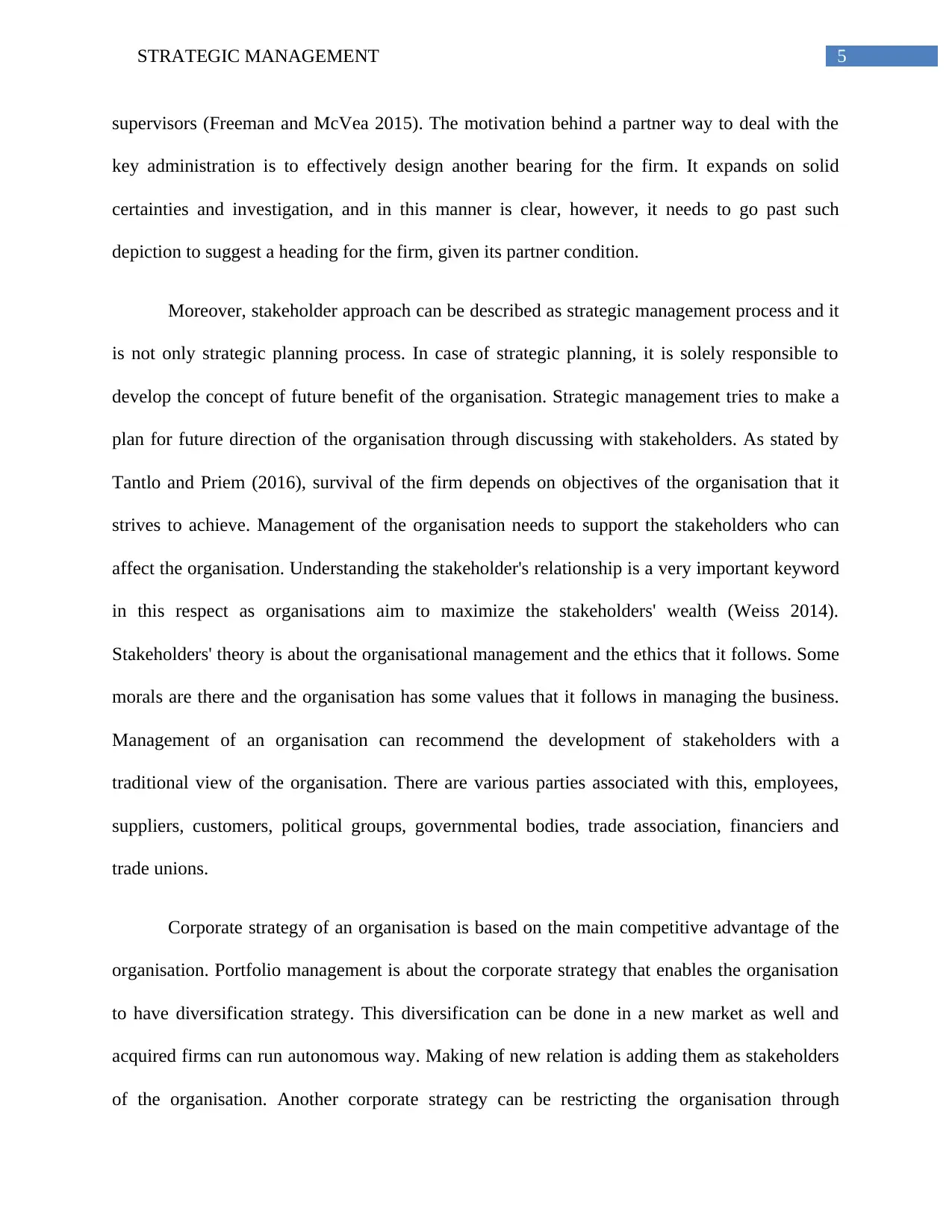
5STRATEGIC MANAGEMENT
supervisors (Freeman and McVea 2015). The motivation behind a partner way to deal with the
key administration is to effectively design another bearing for the firm. It expands on solid
certainties and investigation, and in this manner is clear, however, it needs to go past such
depiction to suggest a heading for the firm, given its partner condition.
Moreover, stakeholder approach can be described as strategic management process and it
is not only strategic planning process. In case of strategic planning, it is solely responsible to
develop the concept of future benefit of the organisation. Strategic management tries to make a
plan for future direction of the organisation through discussing with stakeholders. As stated by
Tantlo and Priem (2016), survival of the firm depends on objectives of the organisation that it
strives to achieve. Management of the organisation needs to support the stakeholders who can
affect the organisation. Understanding the stakeholder's relationship is a very important keyword
in this respect as organisations aim to maximize the stakeholders' wealth (Weiss 2014).
Stakeholders' theory is about the organisational management and the ethics that it follows. Some
morals are there and the organisation has some values that it follows in managing the business.
Management of an organisation can recommend the development of stakeholders with a
traditional view of the organisation. There are various parties associated with this, employees,
suppliers, customers, political groups, governmental bodies, trade association, financiers and
trade unions.
Corporate strategy of an organisation is based on the main competitive advantage of the
organisation. Portfolio management is about the corporate strategy that enables the organisation
to have diversification strategy. This diversification can be done in a new market as well and
acquired firms can run autonomous way. Making of new relation is adding them as stakeholders
of the organisation. Another corporate strategy can be restricting the organisation through
supervisors (Freeman and McVea 2015). The motivation behind a partner way to deal with the
key administration is to effectively design another bearing for the firm. It expands on solid
certainties and investigation, and in this manner is clear, however, it needs to go past such
depiction to suggest a heading for the firm, given its partner condition.
Moreover, stakeholder approach can be described as strategic management process and it
is not only strategic planning process. In case of strategic planning, it is solely responsible to
develop the concept of future benefit of the organisation. Strategic management tries to make a
plan for future direction of the organisation through discussing with stakeholders. As stated by
Tantlo and Priem (2016), survival of the firm depends on objectives of the organisation that it
strives to achieve. Management of the organisation needs to support the stakeholders who can
affect the organisation. Understanding the stakeholder's relationship is a very important keyword
in this respect as organisations aim to maximize the stakeholders' wealth (Weiss 2014).
Stakeholders' theory is about the organisational management and the ethics that it follows. Some
morals are there and the organisation has some values that it follows in managing the business.
Management of an organisation can recommend the development of stakeholders with a
traditional view of the organisation. There are various parties associated with this, employees,
suppliers, customers, political groups, governmental bodies, trade association, financiers and
trade unions.
Corporate strategy of an organisation is based on the main competitive advantage of the
organisation. Portfolio management is about the corporate strategy that enables the organisation
to have diversification strategy. This diversification can be done in a new market as well and
acquired firms can run autonomous way. Making of new relation is adding them as stakeholders
of the organisation. Another corporate strategy can be restricting the organisation through
⊘ This is a preview!⊘
Do you want full access?
Subscribe today to unlock all pages.

Trusted by 1+ million students worldwide
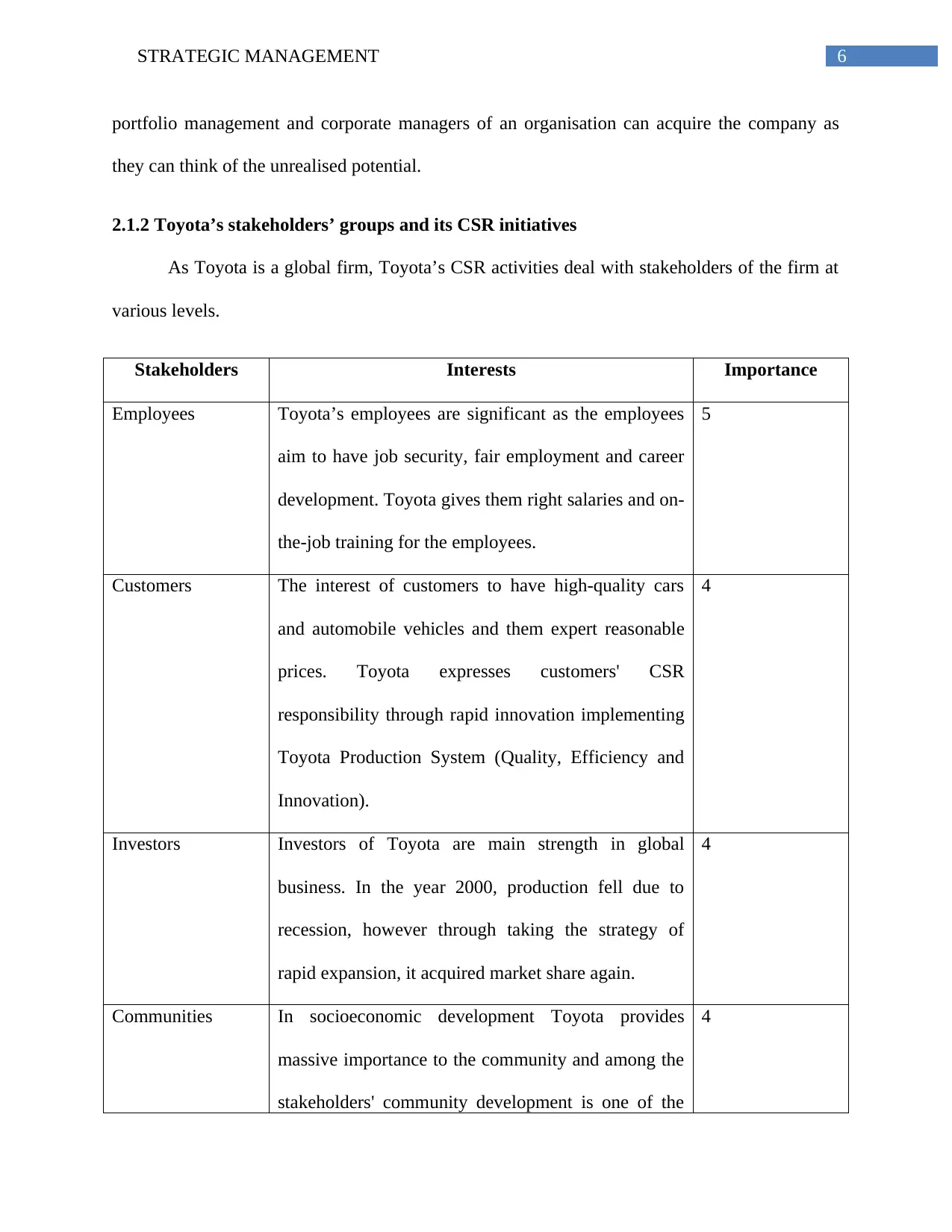
6STRATEGIC MANAGEMENT
portfolio management and corporate managers of an organisation can acquire the company as
they can think of the unrealised potential.
2.1.2 Toyota’s stakeholders’ groups and its CSR initiatives
As Toyota is a global firm, Toyota’s CSR activities deal with stakeholders of the firm at
various levels.
Stakeholders Interests Importance
Employees Toyota’s employees are significant as the employees
aim to have job security, fair employment and career
development. Toyota gives them right salaries and on-
the-job training for the employees.
5
Customers The interest of customers to have high-quality cars
and automobile vehicles and them expert reasonable
prices. Toyota expresses customers' CSR
responsibility through rapid innovation implementing
Toyota Production System (Quality, Efficiency and
Innovation).
4
Investors Investors of Toyota are main strength in global
business. In the year 2000, production fell due to
recession, however through taking the strategy of
rapid expansion, it acquired market share again.
4
Communities In socioeconomic development Toyota provides
massive importance to the community and among the
stakeholders' community development is one of the
4
portfolio management and corporate managers of an organisation can acquire the company as
they can think of the unrealised potential.
2.1.2 Toyota’s stakeholders’ groups and its CSR initiatives
As Toyota is a global firm, Toyota’s CSR activities deal with stakeholders of the firm at
various levels.
Stakeholders Interests Importance
Employees Toyota’s employees are significant as the employees
aim to have job security, fair employment and career
development. Toyota gives them right salaries and on-
the-job training for the employees.
5
Customers The interest of customers to have high-quality cars
and automobile vehicles and them expert reasonable
prices. Toyota expresses customers' CSR
responsibility through rapid innovation implementing
Toyota Production System (Quality, Efficiency and
Innovation).
4
Investors Investors of Toyota are main strength in global
business. In the year 2000, production fell due to
recession, however through taking the strategy of
rapid expansion, it acquired market share again.
4
Communities In socioeconomic development Toyota provides
massive importance to the community and among the
stakeholders' community development is one of the
4
Paraphrase This Document
Need a fresh take? Get an instant paraphrase of this document with our AI Paraphraser
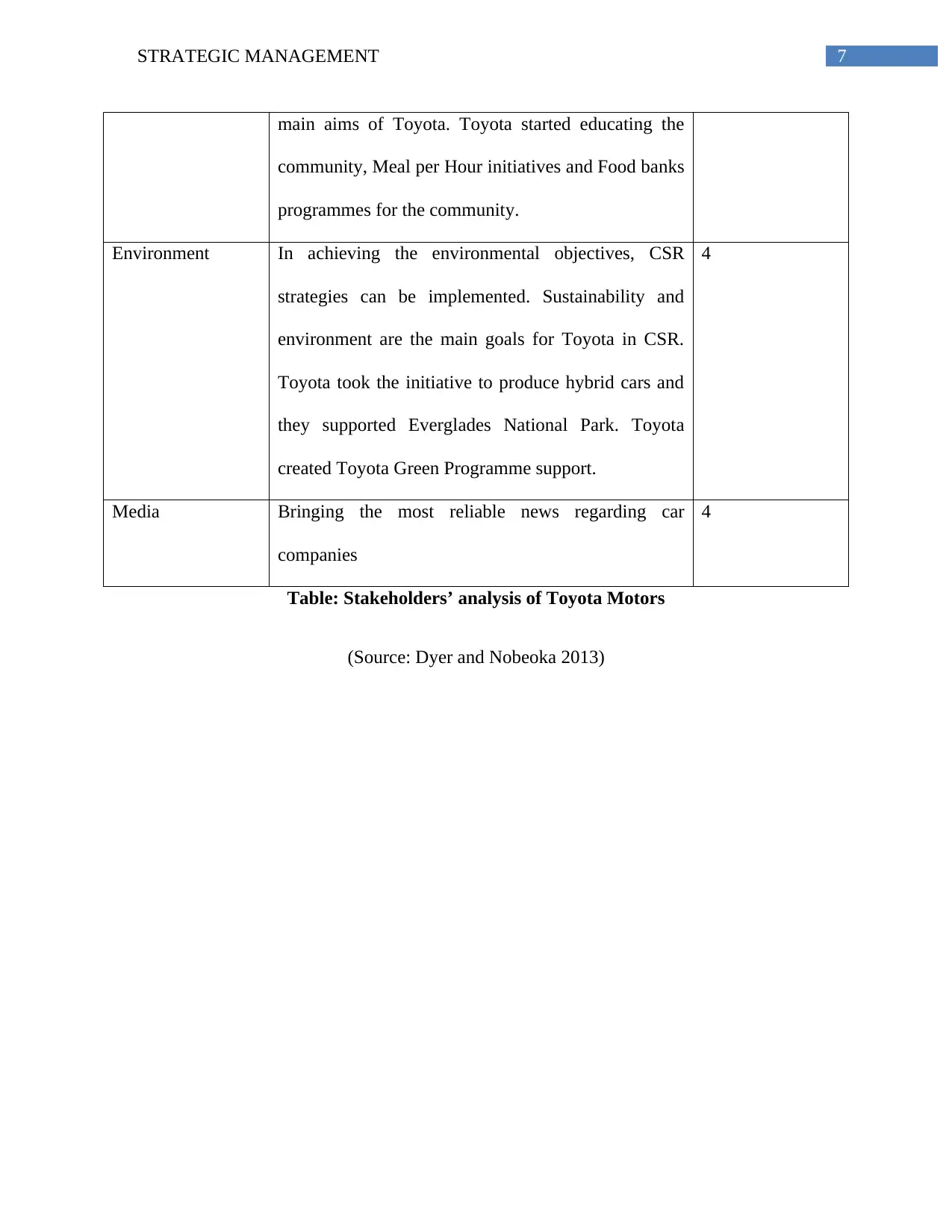
7STRATEGIC MANAGEMENT
main aims of Toyota. Toyota started educating the
community, Meal per Hour initiatives and Food banks
programmes for the community.
Environment In achieving the environmental objectives, CSR
strategies can be implemented. Sustainability and
environment are the main goals for Toyota in CSR.
Toyota took the initiative to produce hybrid cars and
they supported Everglades National Park. Toyota
created Toyota Green Programme support.
4
Media Bringing the most reliable news regarding car
companies
4
Table: Stakeholders’ analysis of Toyota Motors
(Source: Dyer and Nobeoka 2013)
main aims of Toyota. Toyota started educating the
community, Meal per Hour initiatives and Food banks
programmes for the community.
Environment In achieving the environmental objectives, CSR
strategies can be implemented. Sustainability and
environment are the main goals for Toyota in CSR.
Toyota took the initiative to produce hybrid cars and
they supported Everglades National Park. Toyota
created Toyota Green Programme support.
4
Media Bringing the most reliable news regarding car
companies
4
Table: Stakeholders’ analysis of Toyota Motors
(Source: Dyer and Nobeoka 2013)
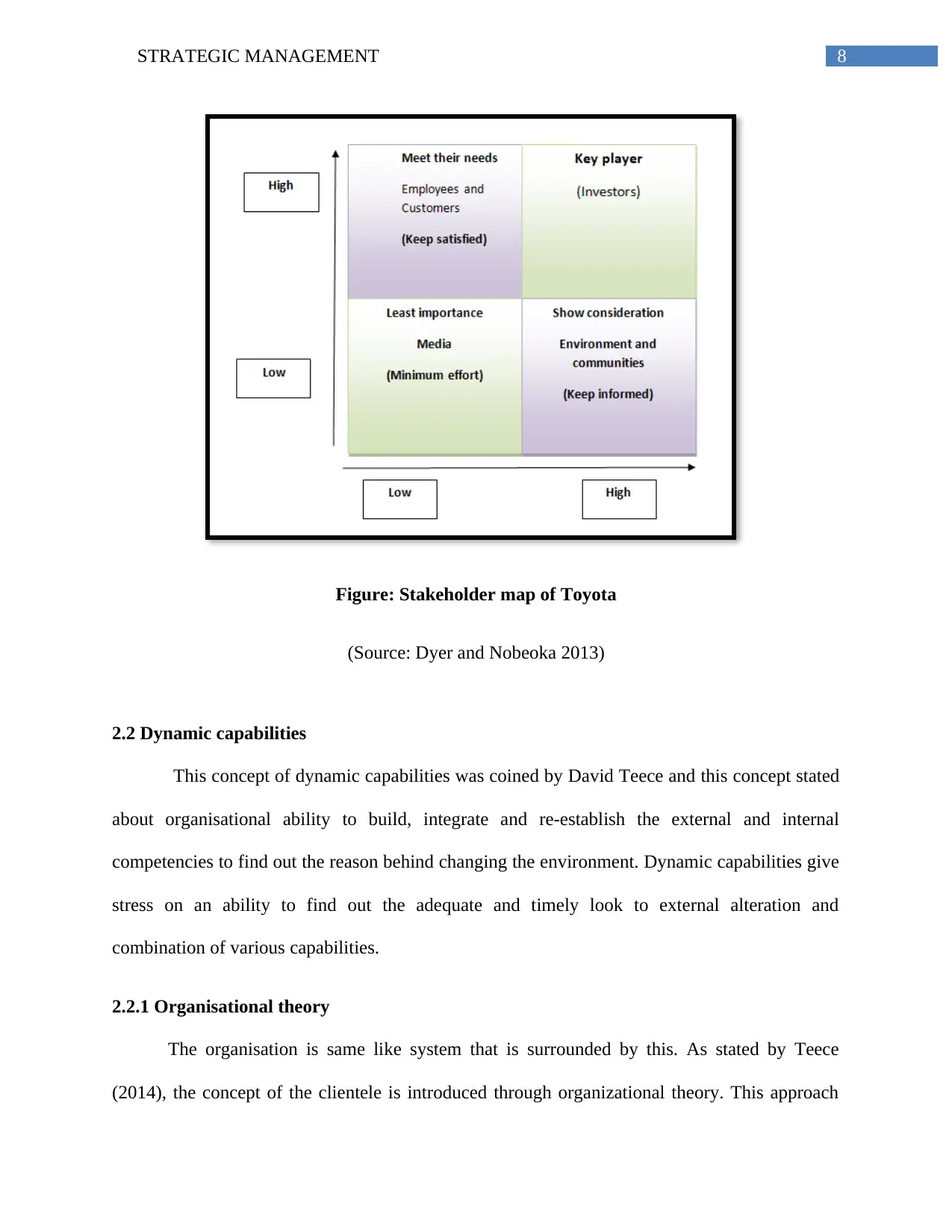
8STRATEGIC MANAGEMENT
Figure: Stakeholder map of Toyota
(Source: Dyer and Nobeoka 2013)
2.2 Dynamic capabilities
This concept of dynamic capabilities was coined by David Teece and this concept stated
about organisational ability to build, integrate and re-establish the external and internal
competencies to find out the reason behind changing the environment. Dynamic capabilities give
stress on an ability to find out the adequate and timely look to external alteration and
combination of various capabilities.
2.2.1 Organisational theory
The organisation is same like system that is surrounded by this. As stated by Teece
(2014), the concept of the clientele is introduced through organizational theory. This approach
Figure: Stakeholder map of Toyota
(Source: Dyer and Nobeoka 2013)
2.2 Dynamic capabilities
This concept of dynamic capabilities was coined by David Teece and this concept stated
about organisational ability to build, integrate and re-establish the external and internal
competencies to find out the reason behind changing the environment. Dynamic capabilities give
stress on an ability to find out the adequate and timely look to external alteration and
combination of various capabilities.
2.2.1 Organisational theory
The organisation is same like system that is surrounded by this. As stated by Teece
(2014), the concept of the clientele is introduced through organizational theory. This approach
⊘ This is a preview!⊘
Do you want full access?
Subscribe today to unlock all pages.

Trusted by 1+ million students worldwide
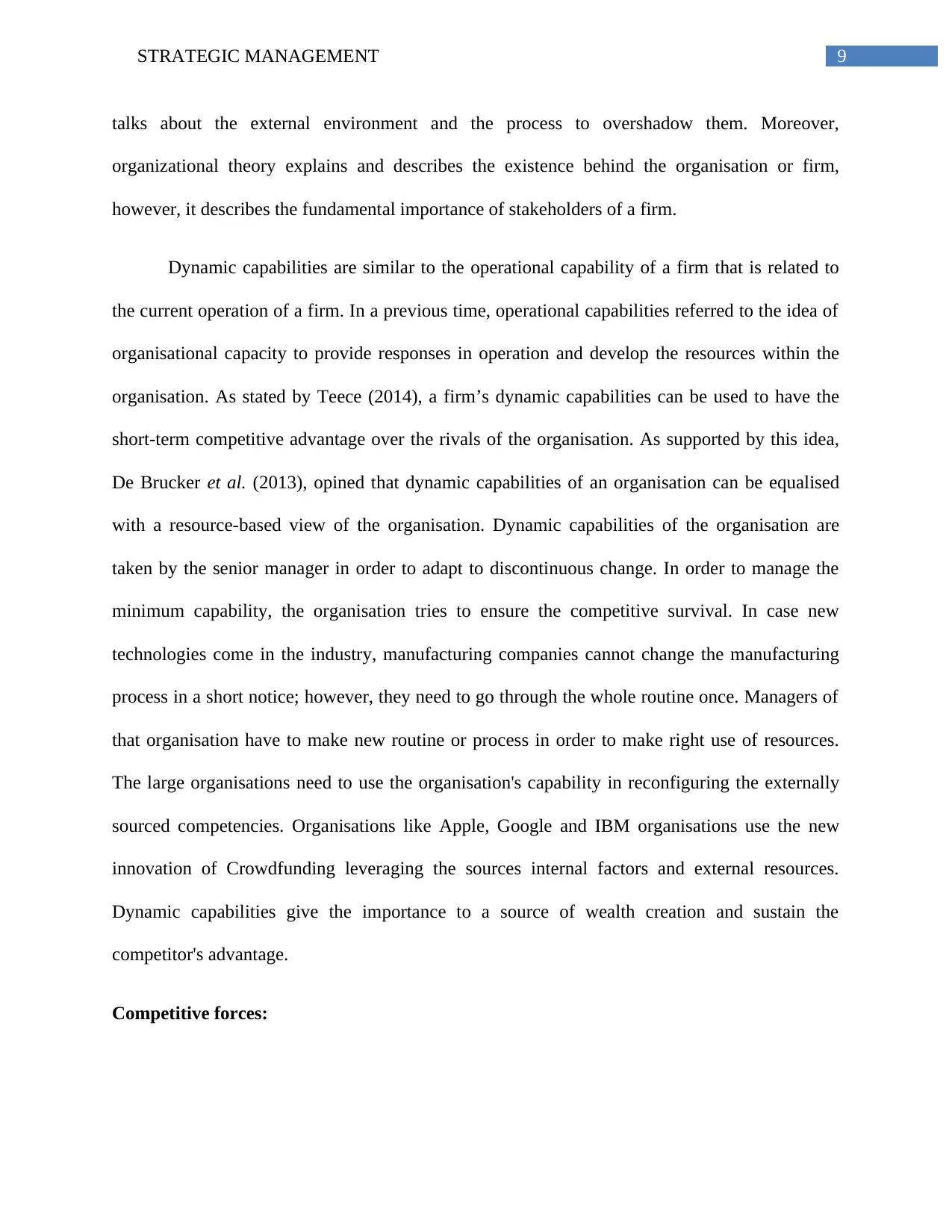
9STRATEGIC MANAGEMENT
talks about the external environment and the process to overshadow them. Moreover,
organizational theory explains and describes the existence behind the organisation or firm,
however, it describes the fundamental importance of stakeholders of a firm.
Dynamic capabilities are similar to the operational capability of a firm that is related to
the current operation of a firm. In a previous time, operational capabilities referred to the idea of
organisational capacity to provide responses in operation and develop the resources within the
organisation. As stated by Teece (2014), a firm’s dynamic capabilities can be used to have the
short-term competitive advantage over the rivals of the organisation. As supported by this idea,
De Brucker et al. (2013), opined that dynamic capabilities of an organisation can be equalised
with a resource-based view of the organisation. Dynamic capabilities of the organisation are
taken by the senior manager in order to adapt to discontinuous change. In order to manage the
minimum capability, the organisation tries to ensure the competitive survival. In case new
technologies come in the industry, manufacturing companies cannot change the manufacturing
process in a short notice; however, they need to go through the whole routine once. Managers of
that organisation have to make new routine or process in order to make right use of resources.
The large organisations need to use the organisation's capability in reconfiguring the externally
sourced competencies. Organisations like Apple, Google and IBM organisations use the new
innovation of Crowdfunding leveraging the sources internal factors and external resources.
Dynamic capabilities give the importance to a source of wealth creation and sustain the
competitor's advantage.
Competitive forces:
talks about the external environment and the process to overshadow them. Moreover,
organizational theory explains and describes the existence behind the organisation or firm,
however, it describes the fundamental importance of stakeholders of a firm.
Dynamic capabilities are similar to the operational capability of a firm that is related to
the current operation of a firm. In a previous time, operational capabilities referred to the idea of
organisational capacity to provide responses in operation and develop the resources within the
organisation. As stated by Teece (2014), a firm’s dynamic capabilities can be used to have the
short-term competitive advantage over the rivals of the organisation. As supported by this idea,
De Brucker et al. (2013), opined that dynamic capabilities of an organisation can be equalised
with a resource-based view of the organisation. Dynamic capabilities of the organisation are
taken by the senior manager in order to adapt to discontinuous change. In order to manage the
minimum capability, the organisation tries to ensure the competitive survival. In case new
technologies come in the industry, manufacturing companies cannot change the manufacturing
process in a short notice; however, they need to go through the whole routine once. Managers of
that organisation have to make new routine or process in order to make right use of resources.
The large organisations need to use the organisation's capability in reconfiguring the externally
sourced competencies. Organisations like Apple, Google and IBM organisations use the new
innovation of Crowdfunding leveraging the sources internal factors and external resources.
Dynamic capabilities give the importance to a source of wealth creation and sustain the
competitor's advantage.
Competitive forces:
Paraphrase This Document
Need a fresh take? Get an instant paraphrase of this document with our AI Paraphraser
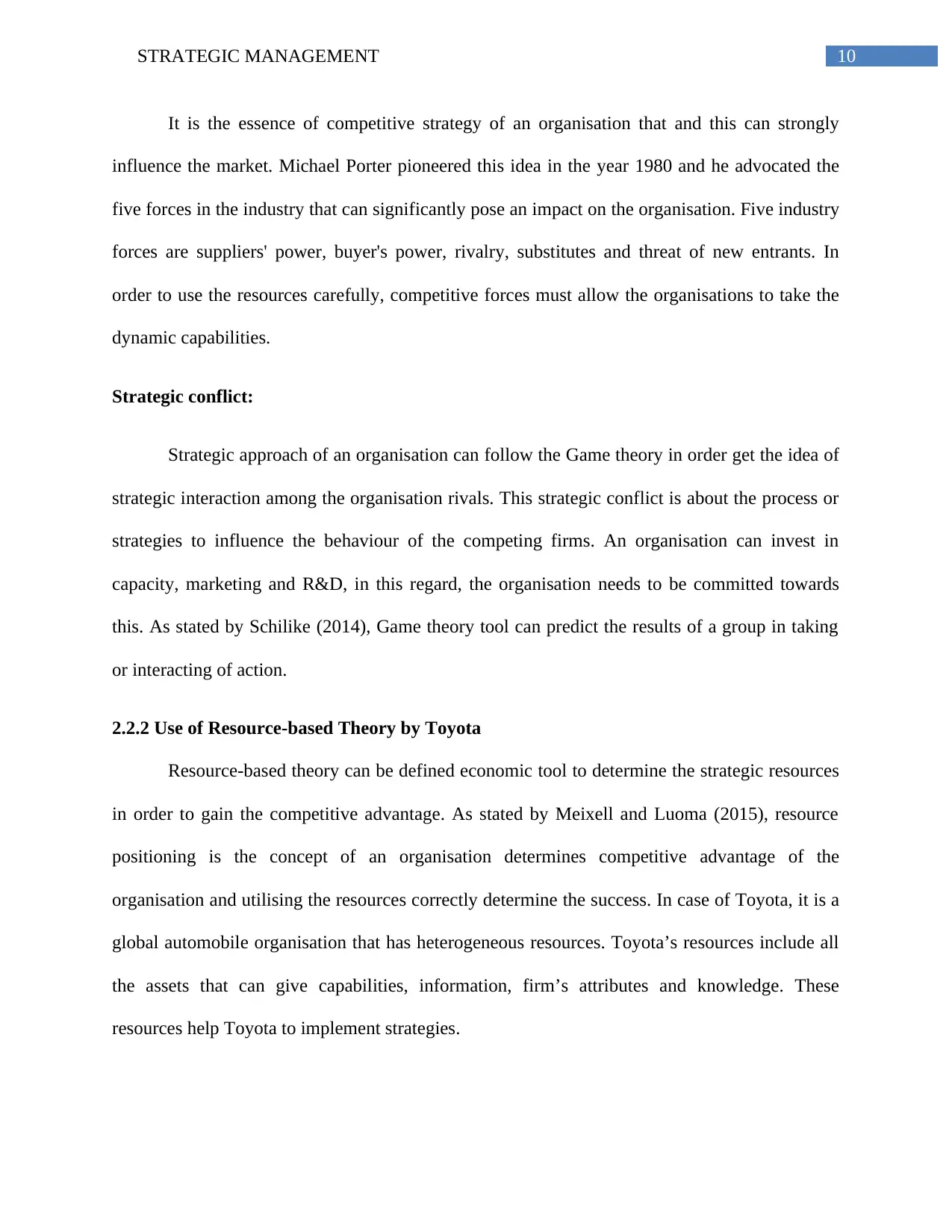
10STRATEGIC MANAGEMENT
It is the essence of competitive strategy of an organisation that and this can strongly
influence the market. Michael Porter pioneered this idea in the year 1980 and he advocated the
five forces in the industry that can significantly pose an impact on the organisation. Five industry
forces are suppliers' power, buyer's power, rivalry, substitutes and threat of new entrants. In
order to use the resources carefully, competitive forces must allow the organisations to take the
dynamic capabilities.
Strategic conflict:
Strategic approach of an organisation can follow the Game theory in order get the idea of
strategic interaction among the organisation rivals. This strategic conflict is about the process or
strategies to influence the behaviour of the competing firms. An organisation can invest in
capacity, marketing and R&D, in this regard, the organisation needs to be committed towards
this. As stated by Schilike (2014), Game theory tool can predict the results of a group in taking
or interacting of action.
2.2.2 Use of Resource-based Theory by Toyota
Resource-based theory can be defined economic tool to determine the strategic resources
in order to gain the competitive advantage. As stated by Meixell and Luoma (2015), resource
positioning is the concept of an organisation determines competitive advantage of the
organisation and utilising the resources correctly determine the success. In case of Toyota, it is a
global automobile organisation that has heterogeneous resources. Toyota’s resources include all
the assets that can give capabilities, information, firm’s attributes and knowledge. These
resources help Toyota to implement strategies.
It is the essence of competitive strategy of an organisation that and this can strongly
influence the market. Michael Porter pioneered this idea in the year 1980 and he advocated the
five forces in the industry that can significantly pose an impact on the organisation. Five industry
forces are suppliers' power, buyer's power, rivalry, substitutes and threat of new entrants. In
order to use the resources carefully, competitive forces must allow the organisations to take the
dynamic capabilities.
Strategic conflict:
Strategic approach of an organisation can follow the Game theory in order get the idea of
strategic interaction among the organisation rivals. This strategic conflict is about the process or
strategies to influence the behaviour of the competing firms. An organisation can invest in
capacity, marketing and R&D, in this regard, the organisation needs to be committed towards
this. As stated by Schilike (2014), Game theory tool can predict the results of a group in taking
or interacting of action.
2.2.2 Use of Resource-based Theory by Toyota
Resource-based theory can be defined economic tool to determine the strategic resources
in order to gain the competitive advantage. As stated by Meixell and Luoma (2015), resource
positioning is the concept of an organisation determines competitive advantage of the
organisation and utilising the resources correctly determine the success. In case of Toyota, it is a
global automobile organisation that has heterogeneous resources. Toyota’s resources include all
the assets that can give capabilities, information, firm’s attributes and knowledge. These
resources help Toyota to implement strategies.
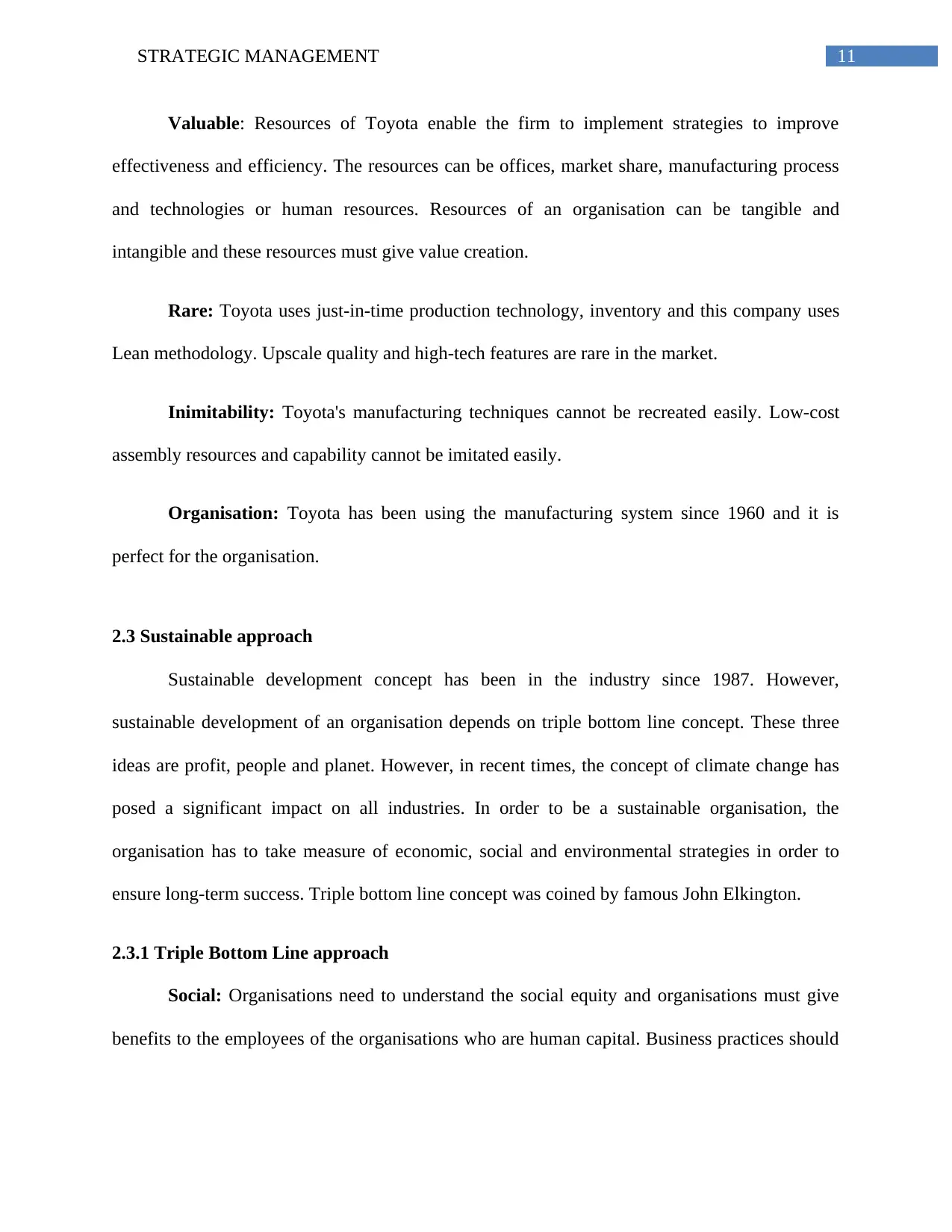
11STRATEGIC MANAGEMENT
Valuable: Resources of Toyota enable the firm to implement strategies to improve
effectiveness and efficiency. The resources can be offices, market share, manufacturing process
and technologies or human resources. Resources of an organisation can be tangible and
intangible and these resources must give value creation.
Rare: Toyota uses just-in-time production technology, inventory and this company uses
Lean methodology. Upscale quality and high-tech features are rare in the market.
Inimitability: Toyota's manufacturing techniques cannot be recreated easily. Low-cost
assembly resources and capability cannot be imitated easily.
Organisation: Toyota has been using the manufacturing system since 1960 and it is
perfect for the organisation.
2.3 Sustainable approach
Sustainable development concept has been in the industry since 1987. However,
sustainable development of an organisation depends on triple bottom line concept. These three
ideas are profit, people and planet. However, in recent times, the concept of climate change has
posed a significant impact on all industries. In order to be a sustainable organisation, the
organisation has to take measure of economic, social and environmental strategies in order to
ensure long-term success. Triple bottom line concept was coined by famous John Elkington.
2.3.1 Triple Bottom Line approach
Social: Organisations need to understand the social equity and organisations must give
benefits to the employees of the organisations who are human capital. Business practices should
Valuable: Resources of Toyota enable the firm to implement strategies to improve
effectiveness and efficiency. The resources can be offices, market share, manufacturing process
and technologies or human resources. Resources of an organisation can be tangible and
intangible and these resources must give value creation.
Rare: Toyota uses just-in-time production technology, inventory and this company uses
Lean methodology. Upscale quality and high-tech features are rare in the market.
Inimitability: Toyota's manufacturing techniques cannot be recreated easily. Low-cost
assembly resources and capability cannot be imitated easily.
Organisation: Toyota has been using the manufacturing system since 1960 and it is
perfect for the organisation.
2.3 Sustainable approach
Sustainable development concept has been in the industry since 1987. However,
sustainable development of an organisation depends on triple bottom line concept. These three
ideas are profit, people and planet. However, in recent times, the concept of climate change has
posed a significant impact on all industries. In order to be a sustainable organisation, the
organisation has to take measure of economic, social and environmental strategies in order to
ensure long-term success. Triple bottom line concept was coined by famous John Elkington.
2.3.1 Triple Bottom Line approach
Social: Organisations need to understand the social equity and organisations must give
benefits to the employees of the organisations who are human capital. Business practices should
⊘ This is a preview!⊘
Do you want full access?
Subscribe today to unlock all pages.

Trusted by 1+ million students worldwide
1 out of 16
Related Documents
Your All-in-One AI-Powered Toolkit for Academic Success.
+13062052269
info@desklib.com
Available 24*7 on WhatsApp / Email
![[object Object]](/_next/static/media/star-bottom.7253800d.svg)
Unlock your academic potential
Copyright © 2020–2025 A2Z Services. All Rights Reserved. Developed and managed by ZUCOL.





